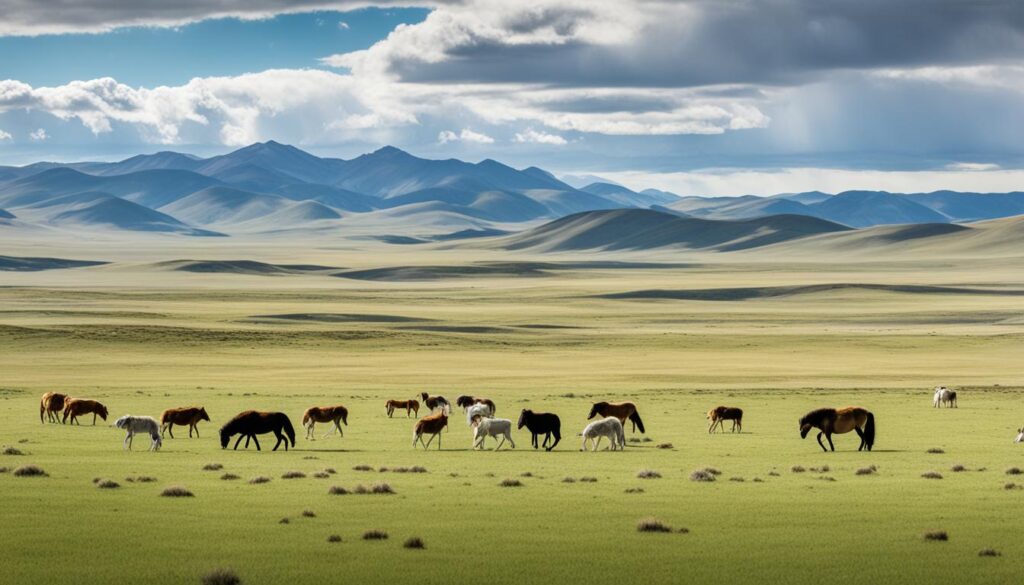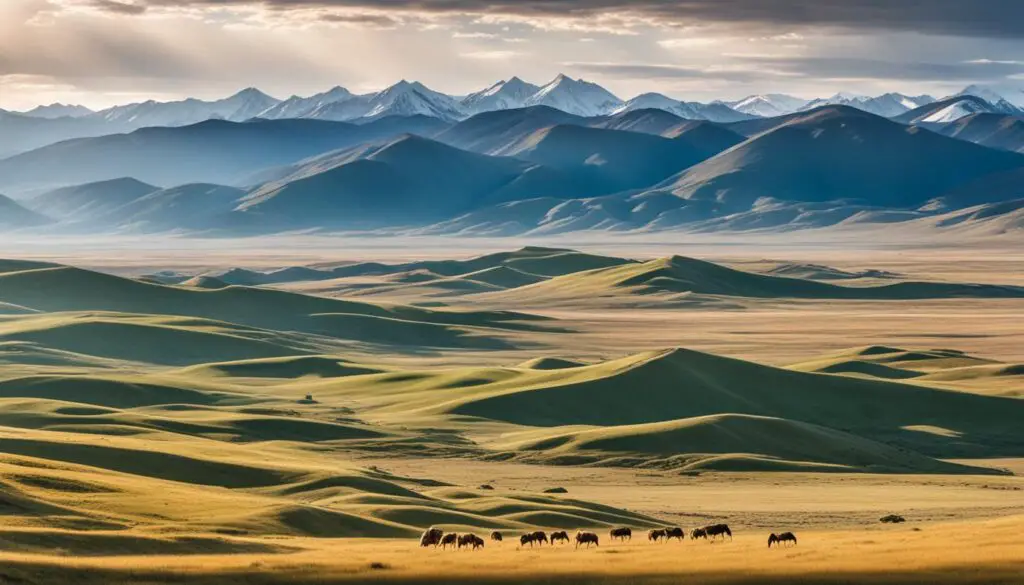Did you know that Mongolia is home to a stunning diversity of animals, despite its challenging environment? Spanning vast deserts, grasslands, and mountains, this landlocked country boasts an impressive array of wildlife, making it a paradise for nature lovers. From endangered species to unique adaptations, Mongolia’s fauna captivates with its beauty and resilience.

Key Takeaways:
- With 139 mammal species, 448 bird species, and numerous reptiles, fish, and amphibians, Mongolia showcases a rich biodiversity.
- Mongolia’s unique geography and climate, ranging from desert steppes to the Gobi Desert, contribute to the diverse habitats that support such a wide variety of species.
- The country has implemented laws and established protected areas to ensure the conservation of its endangered fauna.
- Notable mammals in Mongolia include the rare wild Bactrian camel, the elusive snow leopard, and the majestic Siberian ibex.
- Mongolia is also home to an impressive avian population, with stunning species like the Golden Eagle and the Hooded Crane.
Geography and Topography of Mongolia
Mongolia, a landlocked country nestled between Tibet, Afghan Turkestan, Siberia, and Northeast China, is renowned for its vast and diverse geographical features. From expansive grasslands to dense forests and arid deserts, Mongolia’s topography offers a stunning tapestry of landforms.
The country’s unique drainage pattern includes both seasonal and perennial rivers, contributing to its rich network of lakes. Some rivers, originating from the mountains, flow perennially, while others, connected to saltwater lakes, experience seasonal flow. Notably, Mongolia’s largest freshwater lake, Lake Khövsgöl, holds 65% of the country’s fresh water, making it a valuable natural resource.
Mongolia experiences a continental climate with extreme temperature variations between winter and summer. The climate also varies in terms of precipitation, with some regions receiving less than 4 inches of rainfall annually and others experiencing around 14 inches. These climatic conditions play a significant role in shaping the country’s ecosystems and influencing the distribution of its diverse wildlife.

Mongolia’s Major Rivers and Lakes
| Name | Type | Location |
|---|---|---|
| Tola River | Perennial river | Eastern Mongolia |
| Orkhon River | Perennial river | Central Mongolia |
| Selenge River | Perennial river | Northwestern Mongolia |
| Dalai Lake | Saltwater lake | Western Mongolia |
| Ubs Nuur | Perennial lake | Western Mongolia |
Wildlife Conservation and Protected Areas in Mongolia
Mongolia is committed to the preservation and protection of its diverse wildlife. The government has implemented significant measures to ensure the conservation of endangered species and their habitats. Two key laws, the Mongolian Law on Environmental Protection and the Mongolian Law on Hunting, were enacted in 1995 to regulate commercial exploitation and promote sustainable wildlife management.
To safeguard fragile ecosystems and preserve biodiversity, Mongolia has established a network of protected areas covering approximately 13.8% of its total land area. These protected areas consist of national parks, nature reserves, and natural and historic monuments. Within these areas, hunting, logging, and development activities are strictly prohibited.
Mongolia actively participates in international conservation efforts through its membership in the UNESCO Man and the Biosphere Programme. As part of this program, Mongolia designates certain areas as biosphere reserves, which function as strictly protected areas. These reserves serve as invaluable sanctuaries for endangered species such as the wild Bactrian camel, the snow leopard, and the Gobi bear.

Protected Areas in Mongolia
| Name | Type | Location | Size |
|---|---|---|---|
| Gorkhi-Terelj National Park | National Park | Ulaanbaatar Province | 293,136 ha |
| Khustain Nuruu National Park | National Park | Töv Province | 50,620 ha |
| Tsagaan Suvarga Nature Reserve | Nature Reserve | Ömnögovi Province | 78,713 ha |
| Bogdkhan Uul Strictly Protected Area | Strictly Protected Area | Ulaanbaatar | 41,651 ha |
These protected areas not only provide vital habitats for Mongolia’s unique wildlife but also offer opportunities for research, education, and sustainable tourism. Visitors to these areas have the chance to experience the breathtaking beauty of Mongolia’s landscapes while contributing to the long-term preservation of its natural heritage.
Notable Mammals in Mongolia
Mongolia is renowned for its remarkable variety of mammal species, contributing to the country’s rich wildlife and biodiversity. From elusive predators to majestic herbivores, here are some notable mammals that call Mongolia home:
1. Gray Wolves
The gray wolf, or Canis lupus, is an iconic mammal in Mongolia. These intelligent and adaptable creatures play a vital role in maintaining the balance of the ecosystem. Mongolia’s vast landscapes provide the perfect habitat for gray wolves, allowing them to thrive and contribute to the country’s biodiversity.
2. Siberian Ibex
The Siberian ibex, scientifically known as Capra sibirica, is a species of wild goat that inhabits the mountainous regions of Mongolia. With their impressive curved horns and agile climbing abilities, these herbivorous mammals have adapted to the challenging terrain and harsh conditions of Mongolia’s high-altitude regions.
3. Wild Bactrian Camels
The wild Bactrian camel, Camelus ferus, is one of the most endangered large mammals in the world, with a significant population found in the deserts of Mongolia. These unique mammals have adapted to survive in the extreme desert conditions, making them a symbol of resilience in Mongolia’s wildlife.
4. Snow Leopards
The snow leopard, Panthera uncia, is a highly elusive and majestic big cat that roams the mountainous regions of Mongolia. With its thick fur, powerful physique, and incredible climbing skills, the snow leopard is a top predator in its habitat. Spotting a snow leopard in the wild is a rare and awe-inspiring experience.
5. Mongolian Wild Sheep (Argali)
The argali, scientifically known as Ovis ammon, is the largest wild sheep species in the world and an iconic mammal in Mongolia. These magnificent creatures with their distinctive curved horns inhabit the rocky mountain slopes and grasslands of Mongolia. With their grand appearance and unique behavioral characteristics, they are a symbol of the country’s vast wilderness.
6. Siberian Musk Deer
The Siberian musk deer, Moschus moschiferus, is an endangered mammal species found in Mongolia’s high-altitude regions. These small, solitary deer are known for their musk glands, which produce a strong scent used in traditional medicine. Due to overhunting for their musk, their population has significantly declined, making them a conservation priority in Mongolia.
These notable mammal species contribute to the immense biodiversity and natural heritage of Mongolia. From apex predators to endangered herbivores, each mammal plays a critical role in maintaining the delicate balance of the country’s ecosystems.
Avian Diversity in Mongolia
Mongolia is home to a remarkable variety of bird species, with over 449 recorded in the country. The diverse avian population includes both resident and migratory birds, making Mongolia a paradise for birdwatchers and ornithologists alike. From majestic cranes to impressive birds of prey, Mongolia offers a captivating array of winged wonders.
Among the notable avian species in Mongolia are the endemic Kozlov’s Accentor, the elegant Siberian Crane, the majestic Hooded Crane, the graceful Pied Harrier, the iconic Great Bustard, and the elusive Black Stork. These birds have adapted to the unique environments of Mongolia, thriving in the diverse habitats across the country.
To ensure the protection of bird habitats, Mongolia has designated 70 Important Bird Areas (IBAs) covering 5% of its natural land area. These IBAs serve as crucial breeding grounds and stopover sites for migratory birds, preserving their habitats and providing them with safe spaces for nesting and resting.
In addition to the designated IBAs, Mongolia also offers various bird sanctuaries and national parks that cater to avian conservation. These protected areas create a safe haven for endangered bird species and contribute to the overall preservation of Mongolia’s rich avian biodiversity.
Among the bird of prey species found in Mongolia is the iconic Golden Eagle, which holds great cultural significance in the country. Every year, the Golden Eagle Festival celebrates this majestic bird and the traditional practice of eagle hunting, showcasing the deep connection between Mongolian culture and its avian heritage.
Endangered Bird Species in Mongolia
| Bird Species | Status |
|---|---|
| Siberian Crane | Endangered |
| Hooded Crane | Endangered |
| Saker Falcon | Endangered |
| White-naped Crane | Endangered |
The conservation efforts in Mongolia aim to protect endangered bird species and provide a safe environment for their survival. By safeguarding their habitats and implementing sustainable practices, Mongolia ensures that future generations will be able to appreciate the beauty and diversity of its avian inhabitants.
Conclusion
Mongolia’s incredible wildlife and biodiversity make it a captivating destination for nature enthusiasts. The country’s diverse array of animal species thrives in its varied habitats, from the vast deserts of the Gobi to the lush forests and steppes. Protecting and conserving Mongolia’s wildlife is crucial for maintaining the delicate balance of its ecosystems and preserving the country’s natural heritage for future generations.
Mongolia has implemented conservation efforts through the establishment of protected areas and the enactment of conservation laws. These measures aim to safeguard the unique and valuable wildlife resources in the country. With approximately 13.8% of its land area designated as protected areas, Mongolia is actively working towards maintaining the health and sustainability of its ecosystems.
Visitors to Mongolia have the opportunity to witness and appreciate the beauty of its animals, contributing to sustainable tourism and the appreciation of the country’s wildlife resources. By experiencing the awe-inspiring Mongolian landscapes and encountering its diverse wildlife, visitors develop a deeper understanding of the importance of wildlife conservation and become advocates for the protection of Mongolian ecosystems.
From the iconic snow leopards in the mountains to the fascinating wild Bactrian camels in the deserts, Mongolia’s wildlife is a testament to the country’s rich biodiversity. Continued efforts in conservation and the promotion of responsible tourism will ensure that Mongolia remains a haven for its unique and precious animal species in the years to come.
